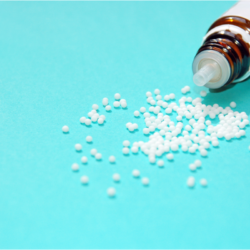Leucorrhoea: Symptoms, Causes and Homeopathic Treatments
Although common, leucorrhoea can be a source of discomfort and concern. Fortunately, homeopathy offers natural and appropriate solutions for treating this condition effectively, while respecting the specific characteristics of each woman. By adopting preventive measures and consulting a health professional in the event of worrying symptoms, it is possible to maintain good intimate health and prevent recurrences.
What is leucorrhoea?
Leucorrhoea, a common gynaecological condition, is characterised by a white or coloured vaginal discharge, often accompanied by pruritus (itching), irritation and lower abdominal pain. Although often benign, this condition requires medical attention in the event of fever or unusual changes in the colour of the secretions.
Leucorrhoea, a gynaecological disorder affecting women of all ages, including young girls, is characterised by abnormal vaginal discharge. Fortunately, homeopathy offers an effective alternative treatment for this condition.
The different types of leucorrhoea
It is important to distinguish between two types of leucorrhoea: physiological leucorrhoea and pathological leucorrhoea.
Physiological leucorrhoea
Physiological leucorrhoea is generally benign and occurs during certain phases of the menstrual cycle or as a result of natural conditions. For example, it may appear during the ovulation period, which is around the 15th day of the menstrual cycle. Other situations such as pregnancy, the menopause or simple vaginal desquamation can also lead to this type of leucorrhoea. This type of leucorrhoea is often odourless and is not accompanied by pruritus or irritation.
Pathological leucorrhoea
Pathological leucorrhoea, on the other hand, is infectious in origin and requires treatment to avoid complications. It can result from vulvovaginitis caused by mycosis or bacteria such as staphylococcus. Sexually transmitted diseases (STDs) such as gonococcus can also cause pathological leucorrhoea, as can PID.
Causes and symptoms of leucorrhoea
The symptoms of leucorrhoea vary according to its type. Physiological leucorrhoea is often normal and does not cause itching or irritation. Pathological leucorrhoea, on the other hand, can manifest itself as a thick, abnormally coloured vaginal discharge (yellow, green), often accompanied by a bad odour, pruritus, irritation and lower abdominal pain.
Symptoms of leucorrhoea
Symptoms of leucorrhoea vary depending on the underlying cause and may include:
- Vaginal discharge: Secretions may be white, yellowish or greenish, with a thick or fluid consistency.
- Pruritus: Itching in the genital area is common.
- Irritation and redness: The skin around the affected area may become red and inflamed.
- Lower abdominal pain: Some women experience pain in the lower abdomen.
- Unpleasant odour: Discharge may sometimes have an unpleasant odour.
Causes of leucorrhoea
Leucorrhoea can be caused by a number of factors:
- Bacterial infections: Bacteria such as Gardnerella vaginalis can cause bacterial vaginosis.
- Fungal infections: The fungus Candida albicans is often responsible for vaginal yeast infections.
- Hormonal imbalances: Hormonal fluctuations, particularly during pregnancy or the menopause, can trigger leucorrhoea.
- Inadequate personal hygiene: Inadequate or excessive personal hygiene can upset the natural balance of vaginal flora.
- Sexually transmitted diseases (STDs ): Certain STDs, such as trichomoniasis, can cause abnormal vaginal discharge.
When should you consult a healthcare professional?
Although leucorrhoea is often benign, certain signs should prompt you to consult a doctor:
- Presence of fever: A high temperature may indicate a more serious infection requiring medical treatment.
- Abnormal colour change: Greenish, greyish or brown discharge may indicate an infection or other health problem.
- Severe abdominal pain: Severe pain in the lower abdomen may be a sign of a pelvic infection or other condition requiring immediate medical attention.
Prevent leucorrhoea
A few simple measures can help prevent leucorrhoea:
- Maintain good intimate hygiene: Use gentle products, avoid douching and wear cotton underwear.
- Avoid irritating products: Avoid intimate deodorants, perfumed soaps and bubble baths, which can upset the vaginal balance.
- Adopt a healthy lifestyle: A balanced diet rich in probiotics and good hydration help to maintain healthy vaginal flora.
- Practice safe sex: Use condoms to reduce the risk of STDs.
What are the symptoms of pathological leucorrhoea?
Pathological leucorrhoea is a condition that requires immediate medical attention to avoid complications. Recognising the symptoms and understanding the different manifestations depending on the pathogen are essential for effective treatment. When in doubt or when these symptoms are present, it is crucial to consult a healthcare professional for diagnosis and appropriate management.
What is pathological leucorrhoea?
Pathological leucorrhoea is caused by infectious germs. This type of leucorrhoea is characterised by the sudden appearance of abnormal vaginal discharge, often accompanied by various functional disorders. The infection may affect the vagina, cervix or corpus uteri, resulting in the production of unusual secretions. Symptoms include vulvar itching, vaginal burning and other specific signs depending on the pathogen involved.
Typical symptoms of pathological leucorrhoea
Itching and burning
One of the first signs of pathological leucorrhoea is the appearance of itching in the vulva. This itching may be accompanied by vaginal burning, making daily life very uncomfortable for the women affected.
Characteristics of vaginal discharge
The nature of vaginal discharge can vary depending on the infectious agent responsible for the leucorrhoea:
- Trichomonas vaginalis: This infection manifests itself as an abundant, greenish discharge with a foul odour. The vulva may also turn a reddish colour due to inflammation.
- Gonococcus: When an infection is caused by gonococcus, the vaginal discharge generally consists of greenish-yellow pus.
- Chlamydia: Chlamydia infection is characterised by purulent leucorrhoea accompanied by metrorrhagia (bleeding outside the menstrual period). In post-menopausal women, this discharge can be particularly purulent, with significant inflammation of the vagina.
Secondary symptoms
In addition to the characteristics of vaginal discharge, pathological leucorrhoea may be accompanied by other symptoms:
- Frequent urination: Women may experience a frequent need to urinate, often accompanied by a burning sensation at the end of passing urine.
- Mild fever: A low-grade fever is often present, especially in infections caused by sexually transmitted diseases.
- Pelvic pain: Infections can spread upwards through the genital tract, causing pain in the pelvis.
Treatments for pathological leucorrhoea: Homeopathic approaches and practical advice
Treating pathological leucorrhoea with homeopathy requires a personalised approach based on the nature and specific symptoms of vaginal discharge. In the event of doubt or severe symptoms, it is essential to consult a doctor for a precise diagnosis and appropriate treatment. Homeopathic treatments, although effective, must be used in conjunction with professional medical care to ensure the health and well-being of patients.
Homeopathic treatment of leucorrhoea
Homeopathy offers solutions for treating both the acute and chronic symptoms of leucorrhoea. Homeopathic remedies are selected according to the specific characteristics of the symptoms, in particular the colour of the secretions.
Common homeopathic remedies
- Pulsatilla: Recommended for thick, yellow or greenish discharge, particularly if it worsens before menstruation.
- Sepia: Effective for yellowish discharge with an unpleasant odour, often accompanied by tiredness and feelings of depression.
- Calcarea carbonica: Suitable for thick, whitish discharge, especially in women who are overweight or have night sweats.
- Natrum muriaticum: Used for white discharge, often associated with sadness and feelings of loneliness.
Homeopathic treatment according to the colour of the leucorrhoea
Homeopathy offers specific treatments based on the colour of the discharge observed. Here is a guide to the remedies recommended according to the colour of the discharge:
- Aqueous leucorrhoea: Luesinum 9 CH is indicated for discharge resembling water.
- Egg-white leucorrhoea: Borax 5 CH is recommended.
- Creamy or yellow leucorrhoea: Pulsatilla 5 CH is recommended.
- Yellow and viscous leucorrhoea: Aletris farinosa 5 CH is recommended for yellow and chronic discharge.
- Greenish leucorrhoea: Mercurius solubilis 5 CH is recommended.
- Brown or blood-tinged leucorrhoea: Nitricum acidum 7 CH is the appropriate remedy.
Homeopathic treatment according to irritation
The degree of irritation caused by the leucorrhoea and its colour also influence the choice of homeopathic treatment:
- Irritant, acidic discharge: Sepia 5 CH is recommended.
- Very irritating, yellow and burning discharge: Kreosotum 5 CH is generally indicated.
- Thick, yellow, very irritating discharge: Hydrastis 4 CH is very effective.
- Non-irritating but yellow discharge: Pulsatilla 7 CH is recommended.
Local and field treatments
For local treatment, it is advisable to use an ovule of Hydrastis calendula at bedtime and to coat the irritated area with Homéoplasmine ointment. In the case of chronic infections with recurrent urinary tract infections, treatment in the field includes :
- Thuja: 5 granules of Thuja 7 CH per day or a weekly dose of Thuja 15 CH.
When should you consult a doctor?
It is crucial to consult a health professional when the following symptoms appear:
- Pain in the lower abdomen: Potential signs of a serious infection.
- Burning and itching: Often indicates an infection that requires medical treatment.
- Foul odour: May indicate a bacterial infection.
- Abnormally coloured discharge: Any unusual change in the colour of the discharge should be assessed by a doctor.
Other homeopathic treatments associated with leucorrhoea
Why are Calcarea Phosphorica and Pulsatilla recommended for the treatment of pathological leucorrhoea?
Calcarea Phosphorica and Pulsatilla are valuable homeopathic remedies in the treatment of pathological leucorrhoea, thanks to their beneficial effects on the immune system, hormonal balance and emotional well-being. Their use enables the symptoms of leucorrhoea to be specifically targeted, depending on their nature and origin, offering a personalised and effective approach to the treatment of this gynaecological condition.
Calcarea Phosphorica
Calcarea Phosphorica, also known as calcium phosphate, is a homeopathic remedy commonly used for various gynaecological disorders, including leucorrhoea. Here’s why this remedy is recommended:
- Strengthening the immune system: Calcarea Phosphorica helps to strengthen the immune system, which is crucial in combating the infections responsible for pathological leucorrhoea.
- Hormonal balance: This remedy is often used to regulate hormonal imbalances, a frequent cause of leucorrhoea. By stabilising hormone levels, Calcarea Phosphorica can help reduce abnormal secretions.
- Improved bone and general health: It is also beneficial for bone and general health, which can be particularly useful for women going through the menopause, a time when hormonal disorders and vaginal infections are more common.
- Treatment of white discharge: Calcarea Phosphorica is specifically indicated for thick white discharge, which is often present in young girls and women undergoing physical development.
Pulsatilla
Pulsatilla, or pulsatilla anemone, is another homeopathic remedy widely used to treat leucorrhoea. Here are the reasons why Pulsatilla is often recommended:
- Adaptability to hormonal changes: Pulsatilla is particularly effective for women whose symptoms vary according to hormonal fluctuations, such as during the menstrual cycle, pregnancy or the menopause.
- Cream-coloured or yellow discharge: This remedy is indicated for cream-coloured or yellow leucorrhoea, which is often thick and has no unpleasant odour. Pulsatilla helps to reduce these secretions and restore the natural balance of the vaginal flora.
- Soothing effect on the emotions: In addition to its physical effects, Pulsatilla is known for its emotionally soothing properties, helping to reduce the stress and anxiety often associated with gynaecological disorders.
- Relief of associated symptoms: Pulsatilla can also relieve symptoms associated with leucorrhoea, such as abdominal pain, itching and burning, improving the patient’s overall comfort.





